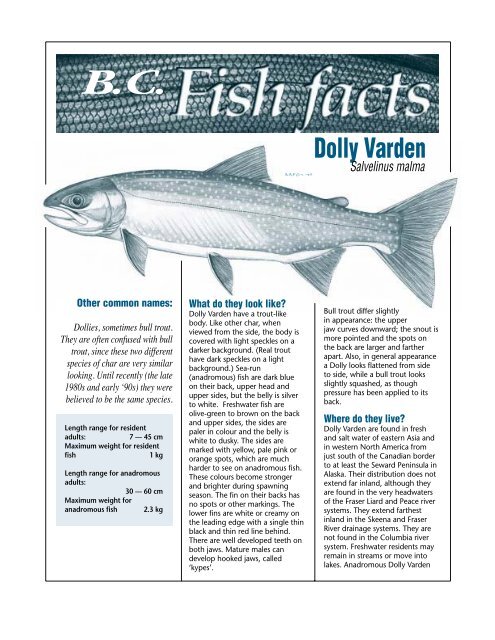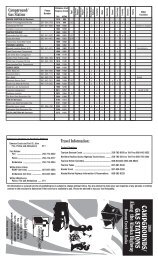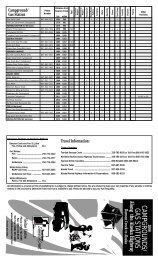Download a full PDF description. - Tourism Dawson Creek
Download a full PDF description. - Tourism Dawson Creek
Download a full PDF description. - Tourism Dawson Creek
- No tags were found...
You also want an ePaper? Increase the reach of your titles
YUMPU automatically turns print PDFs into web optimized ePapers that Google loves.
B.C.Dolly VardenSalvelinus malmaOther common names:Dollies, sometimes bull trout.They are often confused with bulltrout, since these two differentspecies of char are very similarlooking. Until recently (the late1980s and early ‘90s) they werebelieved to be the same species.Length range for residentadults:7 — 45 cmMaximum weight for residentfish1 kgLength range for anadromousadults:30 — 60 cmMaximum weight foranadromous fish 2.3 kgWhat do they look like?Dolly Varden have a trout-likebody. Like other char, whenviewed from the side, the body iscovered with light speckles on adarker background. (Real trouthave dark speckles on a lightbackground.) Sea-run(anadromous) fish are dark blueon their back, upper head andupper sides, but the belly is silverto white. Freshwater fish areolive-green to brown on the backand upper sides, the sides arepaler in colour and the belly iswhite to dusky. The sides aremarked with yellow, pale pink ororange spots, which are muchharder to see on anadromous fish.These colours become strongerand brighter during spawningseason. The fin on their backs hasno spots or other markings. Thelower fins are white or creamy onthe leading edge with a single thinblack and thin red line behind.There are well developed teeth onboth jaws. Mature males candevelop hooked jaws, called‘kypes’.Bull trout differ slightlyin appearance: the upperjaw curves downward; the snout ismore pointed and the spots onthe back are larger and fartherapart. Also, in general appearancea Dolly looks flattened from sideto side, while a bull trout looksslightly squashed, as thoughpressure has been applied to itsback.Where do they live?Dolly Varden are found in freshand salt water of eastern Asia andin western North America fromjust south of the Canadian borderto at least the Seward Peninsula inAlaska. Their distribution does notextend far inland, although theyare found in the very headwatersof the Fraser Liard and Peace riversystems. They extend farthestinland in the Skeena and FraserRiver drainage systems. They arenot found in the Columbia riversystem. Freshwater residents mayremain in streams or move intolakes. Anadromous Dolly Varden
spend time in the ocean as well asin rivers and streams; they do notseem to move out into the openocean, but remain close to rivermouths and the shore. Residentfish can be found in very steep,small streams (with slopes wellabove 20%).What do they eat?Dolly Varden eat aquatic insects,sometimes fish eggs, and smallerfish. Not very long ago thispredatory behaviour wasdespised.What is their life cycle like?Adults are usually sexually maturebetween three and six years ofage; after this age they mayspawn every year in the fall. Innortherly areas, they may spawnonly every other year. They spawnearlier in the season in the northand later in the south. Femalesmake a gravel nest (a redd) for theeggs in the stream bottom. Theeggs hatch in the spring and thealevins emerge from the gravel inlate April to mid-May, when theyare about 20 — 25 mm long.Both anadromous and freshwaterforms remain in fresh water forthe first three to four years.Anadromous forms migrate to theocean to feed in coastal water.They will occasionally moveQueenCharlotteCityPrince RupertDistributionYUKONVictoriaPrinceGeorge<strong>Dawson</strong> <strong>Creek</strong>VancouverN.W.T.Fort St. JohnWilliamsLakeKamloopsU.S.A.Washingtonupstream again to take advantageof seasonal feeding opportunities.They may migrate up a stream thatleads to a lake to overwinter and inthe spring go back to sea. Thisback-and-forth migrationcontinues for a few years until it istime to spawn, when they seek outthe river in which they were born.Different migratory forms (streamresident,river-migratory, lakemigratoryand anadromous) canlive in the same river system.How are they doing?Dolly Varden is blue-listed, whichmeans that this species isconsidered vulnerable in BritishColumbia. They are sensitive tohabitat changes, includingdisruption of migration routes,sedimentation and increasingwater temperature. Manypopulations have declined as aresult of urbanization, damconstruction, industrial activity,road building or over-fishing(including poaching).How you can help:• Be fish aware ... don’t thinkthose small, steep, cold streamsdo not contain fish. That’s Dollyor bull trout habitat!• It is important to obeyregulations, habitat protectionbylaws, and guidelines, sincethey were designed toprotect the fish andtheir habitat. Youshould also Observe,Record and Reportviolations ofregulations byphoning1-800-663-9453.ALBERTA.NelsonMontana• Since Dolly Vardenare vulnerable to overharvest,using abarbless hook andpracticing catch andrelease arerecommended.• Fish are vulnerableto shrub- and treecutting,whichincreases sedimentation,reduces cover and raises watertemperature. If you ownproperty bordering a stream, tryto protect the streamsidevegetation which providesshade and prevents the bankfrom eroding.• Be aware that what you dumpinto your septic tank or roadsidestorm drain may find its wayinto streams or lakes. Help keepwater quality high by usingdetergents and soaps minimallyand do not dump harshchemicals, such as bleach, paintthinner or antifreeze, intodrains.• Form a group of water stewardsand volunteer to monitor localwater quality.No kidding!• Dolly Varden once had a badreputation, since it sometimesfeeds on the eggs and young ofsalmon. Alaska, at one time, hada bounty of 2.5 cents per fishand thousands were killed afterbeing caught in traps and weirs.They are now recognized fortheir own beauty and value as anative sport fish.• In Alaska they can live to be 12years of age.• The Dolly Varden is the only fishin B.C. with a first and last name... like you. That’s why bothnames are capitalized. It isbelieved to be named after aflashy dresser in CharlesDickens’ novel “Barnaby Rudge”(or, perhaps, a once-popularcalico print, with pink spots ona grey background, that wasnamed after this character).Ministry of Fisheries















